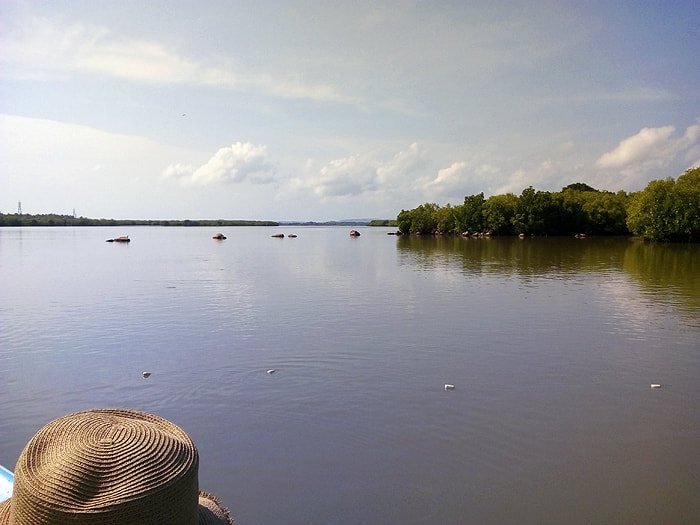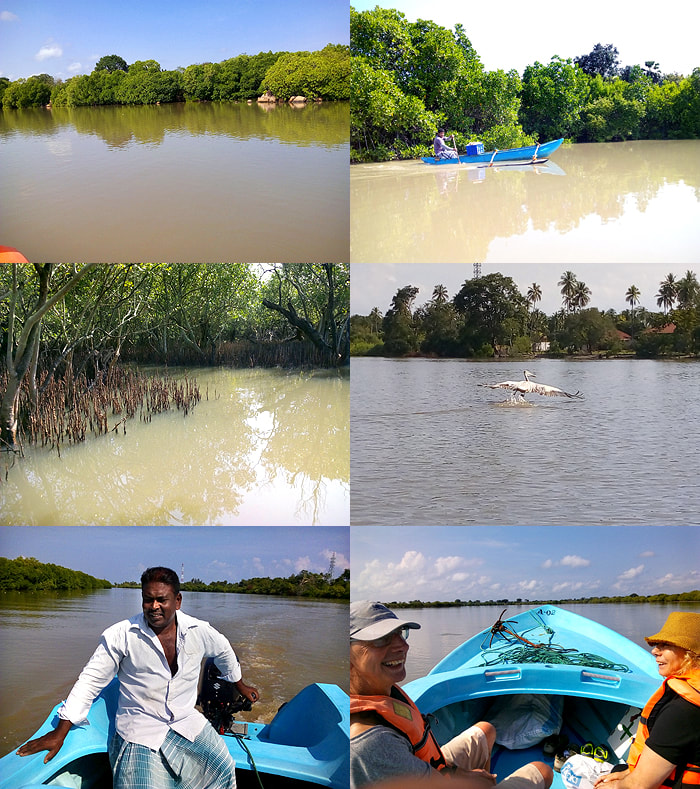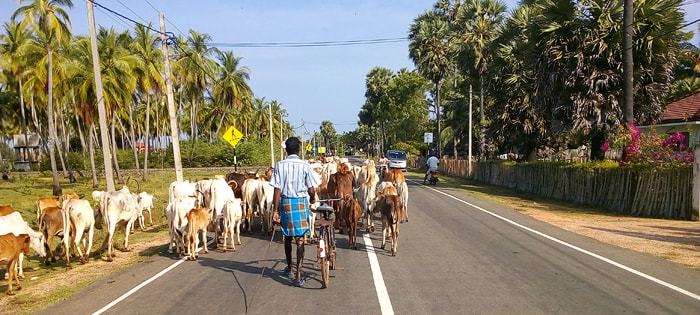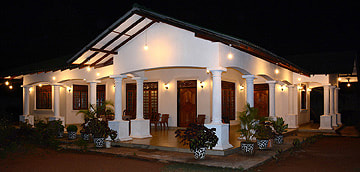|
Sinnakarachchi is the name of the lagoon of Nilaveli. It's situated to the north of Trincomalee. The famous holiday destination Nilaveli Beach is a 7.5 km long and 1.5 km wide spit of land in between the ocean and this Sinnakarachchi Lagoon, which opens to the sea north of Nilaveli, just below the bridge connecting the villages of Irakkakandi and Kumpurupiddi. Actually, the former village is also namegiving to the lagoon of Nilaveli, as Sinnakarachchi Lagoon is sometimes called Irakkakandi Lagoon. The mouth of the lagoon near Irakkakandi village is not far away from the maritime National Park of Pigeon Island. Boat tours to all maritime places of interest near Nilaveli - Pigeon Island, Coral Garden plus Red Rock, and Sinnakarachchi Lagoon - are offered by the Nilaveli Tourist Boat Services Cooperative Society Limited, which is a registered body of boat owners in and around Nilaveli. They also organize dolphin and whale watching tours and deep sea fishing. Their office is at the beach site of Nilaveli. Sinnakarachchi Lagoon has two separate major arms, covering 780 hectares altogether. The main part behind Nilaveli Beaches stretches 9.5 km to the south in a slightly curved way. An even more curved northern arm stretches 5 km inland. The calm lagoon, which is connected with the ocean only by a small natural canal, is used as a sheltered anchorage for fishing boats. With a maximum depth of 2 m, Sinnakaracchi Lagoon is fairly shallow and its water is more than brackish, actually it is categorized hypersaline. At several places along the lagoon's shores, crystallization of salt can occur during the dry season naturally. However, due to ist high salinity, salt pans for salt production were developed additionally, similar to those in Puttalam Lagoon at the west coast. Nilaveli Beach holiday makers interested in seeing salines, however, should travel 2 km further north to Periyakarachchi Lagoon near Vallipunam, where more salt pans can be seen, very close to the main road to Pulmoddai (B 424). Due to ist mangrove swamps, seagrass beds and inter-tidal mudflats, Sinnakarachchi Lagoon is an important natural habitat of Sri Lanka's Eastern Province, particularly for waterbirds. However, the eco-system is threatend by the development of new aquaculture, whereas small subsistence fishery is the traditional way of using the lagoon. Wild elephants are known to frequent the area to the west of Sinnakarachchi Lagoon. Boat services to the wetlands of Sinnakarachchi Lagoon start near Pulmoddai road (B 424) of Nilaveli Beach.
1 Comment
Marcia
11/24/2020 09:37:24 am
I am coming to this area at the end of next year for 10 weeks raising funds for women and children in Sri Lanka. May I use a couple of your photos for my blog to help raise funds?
Reply
Leave a Reply. |
AuthorNuwan Chinthaka Gajanayaka, Categories
All
Archives
June 2020
Buddhism A-Z
|
|
Find a list of 270 Sri Lanka travel destinations & attractions: CLICK HERE Our illustrated list of places of interest is sorted by travel regions, more precisely: by 22 most recommendable places for overnight stays. All 270 sights are within day-trip distance from one of those 22 major locations. (Please understand: Loading 270 images requires more seconds than usual.) |
Why travel with Lanka Excursions Holidays?
+ We are a local agency owned and run by Sri Lankans, not part of international holdings
+ We are well known for our direct and personal relationships with travellers
+ We facilitate authentic meetings with locals who are not from the tourism sector
+ We follow a strict policy not to push guests to visit shops and shops and shops
+ We have an unrivalled expertise to show you places off the beaten path
+ We provide genuine information instead of clichés and tourism industry slogans
+ We are a local agency owned and run by Sri Lankans, not part of international holdings
+ We are well known for our direct and personal relationships with travellers
+ We facilitate authentic meetings with locals who are not from the tourism sector
+ We follow a strict policy not to push guests to visit shops and shops and shops
+ We have an unrivalled expertise to show you places off the beaten path
+ We provide genuine information instead of clichés and tourism industry slogans
Our ambition is to provide high-quality information in preparation of your Sri Lanka holidays
... and even more superb travel experiences
... and even more superb travel experiences
we also run our own guesthouse near Anuradhapura:
First House Mihintale
87, Missaka Mawatha, Mihintale 50300, Sri Lanka.
0094 71 6097795
87, Missaka Mawatha, Mihintale 50300, Sri Lanka.
0094 71 6097795
|
Lanka Excursions Holidays
Registration Number SLTDA/SQA/TA/02179
255/24, "Green Park" Dawatagahawatta, Thimbirigaskatuwa, Mahahunupitiya East, Negombo, Sri Lanka
Office: +94 31 223 991 Hotline: +94 71 6097795 [email protected] Lanka Excursions Holidays office hours 8.00 to 6.00 p.m. daily (except from June Fullmoon Day)
|
if not stated otherwise, texts and photos provided by Ernst A. Sundermann, sales manager of Lanka Excursions Holidays
all rights reserved, © 2016 Lanka Excursion Holidays
all rights reserved, © 2016 Lanka Excursion Holidays



 RSS Feed
RSS Feed



